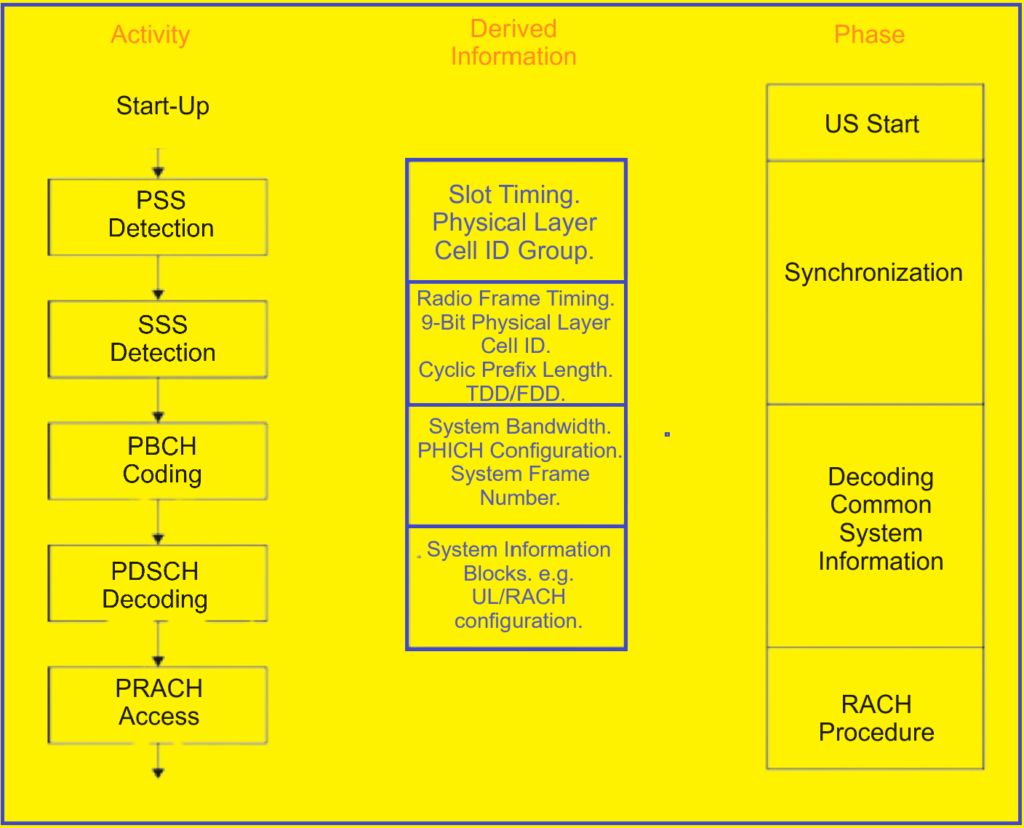LTE cell searching, also known as downlink (DL) synchronization, is a process for resolving primary synchronization signals (PSS) and secondary synchronization signals (SSS) on the DL. This process is essential for the mobile device (UE) to synchronize with the LTE network.
In Frequency Division Duplex (FDD) mode, PSSs are located on the last OFDM symbol of slot 0 and slot 10, while SSSs are positioned on the second OFDM symbol from the end of slot 0 and slot 10.

In Time Division Duplex (TDD) mode, PSSs appear on the second OFDM symbol from the end of slot 2 and slot 12, and SSSs on the last OFDM symbol of slot 1 and slot 11. The PSSs are consistent across transmissions from the two slots, but the SSSs differ between the slots.
Resolving a PSS triggers a 5 ms timer, and resolving an SSS triggers a 10 ms timer. Once the 5 ms timer starts, the UE can determine whether the network operates in FDD or TDD mode based on the location of the SSS resolution.
Regardless of the system bandwidth, PSSs and SSSs are transmitted on six resource blocks (RBs) of the system bandwidth to ensure symmetric intra-bandwidth transmission. Thus, resolving PSSs and SSSs helps in achieving frequency synchronization.
The physical layer cell ID can be obtained using PSS resolution, the cell group ID can be derived using SSS resolution, and the physical cell ID of the current cell can be determined by combining both PSS and SSS resolutions.
The physical cell identifiers (PCIs) of the current cell are calculated as follows:
PCIs of the current cell=(Cell group ID×3)+Cell ID.
There are 504 possible cell IDs divided into 168 groups, and each group has three cell PCIs.
Initial UE Radio Access.
Cell search is a critical procedure in LTE for synchronizing time and frequency to a base station sector. This process also includes deriving essential information about the target cell. LTE uses a hierarchical cell search method similar to WCDMA UMTS. The primary synchronization signal (PSS) and secondary synchronization signal (SSS) provide radio frame and slot synchronization, as well as additional information like duplex mode (TDD or FDD) and the physical layer group and cell identity (c-ID).
When UEs synchronize to a new LTE cell, they start by searching for a PSS, which is a Zadoff–Chu sequence. There are three defined PSS sequences, each indicating a physical cell group ID. LTE defines three physical layer c-ID groups, each containing 168 physical layer c-IDs.
After successfully detecting the PSS and identifying its physical layer c-ID group and slot timing, the UE then decodes the SSS, which is broadcasted one OFDM symbol prior to the PSS. This decoding allows the UE to retrieve DL slot, radio frame timing, and frequency synchronization. By successfully decoding both PSS and SSS, the UE obtains the complete 9-bit physical layer c-ID, the radio frame type (either type 1 for FDD or type 2 for TDD), and the cyclic prefix (CP) length.
The initial steps of cell synchronization and access are illustrated in Figure below. After synchronization, the UE is ready to detect and decode the Physical Broadcast Channel (PBCH) to derive the system bandwidth, PHICH configuration, and the current System Frame Number (SFN). Subsequently, the UE needs to retrieve other common system information from the Downlink Shared Channel (DL-SCH).

System Information Blocks (SIBs) are scheduled on regular shared channel resources using a special Cell Radio Network Temporary Identifier (C-RNTI) = 0xFFFF. SIBs provide general system configuration information such as uplink (UL) configuration and random access configuration.
With this procedure, the UE is ready to initiate the random access procedure.